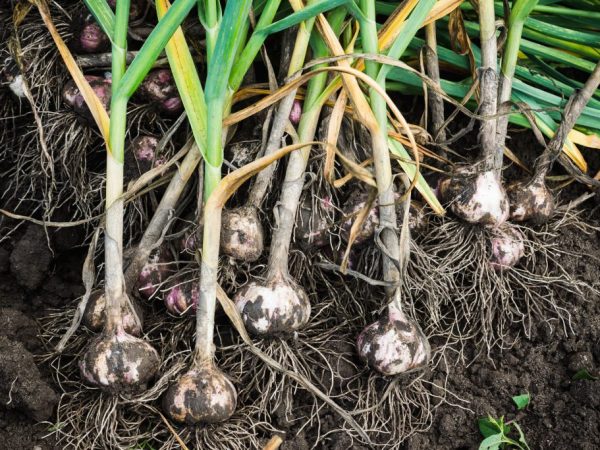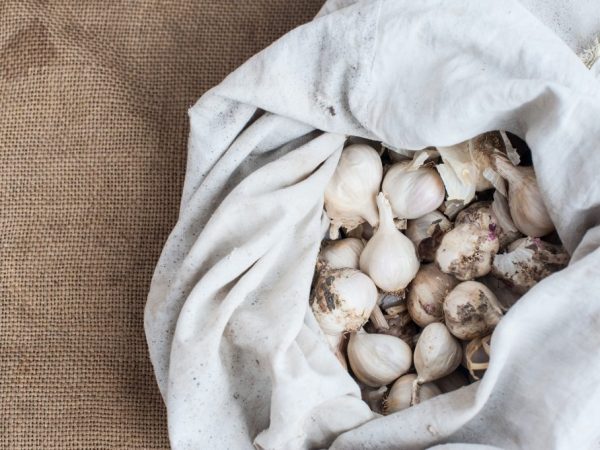When the garlic is harvested
Many novice gardeners are worried about the correct harvesting of garlic. Winter and summer varieties should lie for a long time without losing their qualities. That is why experienced summer residents have their own secrets. Harvesting and proper storage of the crop will help preserve the taste and useful properties of the product.

Harvesting garlic
This vegetable is not capricious in cultivation, but requires care and timely harvesting if you want to get a high-quality and tasty harvest. It is necessary not only to plant and dig up garlic on time, but also to be able to store it in the right conditions.
Why is it important to harvest on time?
This question is asked by many novice summer residents. This vegetable is easy to grow and prepare and has many health benefits. But why is it so important to harvest on time and correctly?
Harvesting any kind of garlic usually takes 5-10 days, which is enough to guess the weather and collect all the vegetables in one go. The main thing to remember is that it is better to remove the vegetable unripe. It has the ability to ripen during drying. Overripe will sprout a second sprout, giving shoots and losing its nutritional value.
Delay in digging and pruning can result in flake breakage and dehulling denticles. Such a crop will not last until January. It will become dry and unusable.
Winter garlic harvesting
As a spice, garlic is very popular in various cuisines. Now it is impossible to imagine the usual and familiar to us dishes without this interesting, but simple ingredient. The winter variety is most often used as a spice. It is superior to the spring crop in terms of shelf life and appearance. They also differ in taste and useful properties. They plant winter garlic before winter, hence the name. It is impossible to say the exact number of days after how long the garlic will be ripe and tasty, but a lot also depends on the type of vegetable.
Digging time
Early maturing varieties are ready for digging in 85-90 days. Late-ripening variety - 100-105 days.
Harvesting winter garlic is a simple and complex procedure at the same time. If you skip the harvesting dates for winter garlic, or vice versa, dig up the vegetables earlier, then there is a high probability of spoiling the qualities of the product. The main misconception of novice gardeners is that rain and moisture are dangerous for garlic.
The time of digging up this particular variety affects its further presentation, taste. Regardless of in what territories or in what land the garlic grew, it is important to be able to determine how ripe the vegetable is and to choose the right time to harvest the garlic.
In the middle lane for winter garlic, harvesting time occurs in the last days of June or in the middle of July (best of all, Petrov Holiday on July 12). In the northwest, these dates are postponed by a month, that is, the end of August, the beginning of September.
The exception is one-toothed (young heads). They ripen 20-25 days earlier than any early-ripening winter variety. This means that it quickly starts up arrows in case of overgrowth.And also you need to remove the garlic either in the morning or in the evening. Hot weather and strong rays of the sun at lunchtime can spoil the presentation of the crop and kill the beneficial properties.
How to check the ripeness of a vegetable
If you are unsure of the ripeness of the vegetable, carefully dig up a few heads of garlic. They should be firm in sensations, the scales should easily come off, but not crumble, the cloves should be well separated. Another factor in the maturity of the crop will be yellowed lower leaves. Then it will be a sign that all the useful elements have passed from the aboveground part to the head and it's time for cleaning.
Harvesting spring garlic

Harvesting depending on the variety and planting time
Large winter garlic is excellent as a spice, while spring garlic retains its nutritional properties longer. The second is planted later, in the spring, so the harvest is harvested in late August - early September.
Digging time
The weather in autumn is very unpredictable. The harvesting dates for spring (summer) garlic must not be skipped. Due to humidity and rain, new young roots may start growing, garlic bulbs will no longer be useful, and their shelf life will decrease. Much also depends on caring for the vegetable, feeding in spring and summer, weather and variety.
The main sign of the ripening of the crop is yellowing and lodging of old stems and leaves. The timing of picking vegetables must be accurate, because of your mistakes, you can lose a whole store of useful properties.
Garlic storage rules
Before dealing with proper storage, you need to understand what to do after digging the crop. You need to dig carefully, forks are best for this, mechanical cleaning is not suitable. Do not cut the tops and roots, this is the next step after drying. Make sure there will be sun on the day of cleaning, without rain or dampness.
After digging, take the food under a shed, away from the sun and closer to the draft. Without cleaning or cutting anything, you need to hang or spread the bundles, depending on the availability of free space. Lay out in one layer to dry better.
After two weeks, you can continue harvesting: shake off the ground, cut the tops, prepare for storage. The storage rules for summer garlic are simple: it will be comfortable both in warmth and in cool rooms (up to 1 ° C). Store winter in the cold. Dry and well-ventilated areas are best suited for this.
When planting and harvesting garlic on an industrial scale, the shelf life of the crop in one room is significantly reduced. It is transported to shops or other industries. In the first days, small bulbs are given, and only then large ones, they can be stored longer.
How to store at home
If there is no harvest at all or not so much, and summer residents grow vegetables for themselves, there are 5 main ways to store garlic at home.
- So that the bottom of the head is not infected with an infection, you need to carefully burn it and put it in an open glass jar for at least 2 months. This will prevent rotting and drying out.
- One of the popular storage methods is nylon tights or mesh. Harvests of any variety are folded there and hung in a dry and cool room.
- After drying the vegetables for about 3 weeks, put them in a plastic bag and bury them in the ground to a depth of 45 cm. You can bury them on the plot or at home in a box. The main thing is that the ground is dry. Dig up the bulbs before the spring thaw.
- Often the crop is placed in a cloth bag (flax) and hung in a dry, well-ventilated area.
- Salt is a product that any housewife has in the house. For a long shelf life, put the garlic in a plastic box or box and sprinkle each layer with salt. Remove to a cellar or other cool place (balcony, corridor).
It is important to remember and know that if you want to end up with a high-quality and healthy product, you need to comply with the terms of harvesting garlic, storage rules and further planting of the crop.Each of these methods is very simple, you don't need to make a lot of effort to repeat at least one of them.
Conclusion
When to harvest garlic, how to dig it out correctly, which seeds to choose for planting garlic, tricks in digging out the beds, what time is it for harvesting and how to store it? These are the most common problems for gardeners. It is not necessary to know clearly the date of putting things in order, you need to be able to navigate in the ripening of vegetables.
Harvesting, storing garlic and onions are somewhat similar, but you still need to know the differences and not be confused. It is important to remember that it is better to harvest the crop in dry weather, dry it well and clean it. Only then will this vegetable give you not only its beneficial and nutritious properties, but also a good profit.


